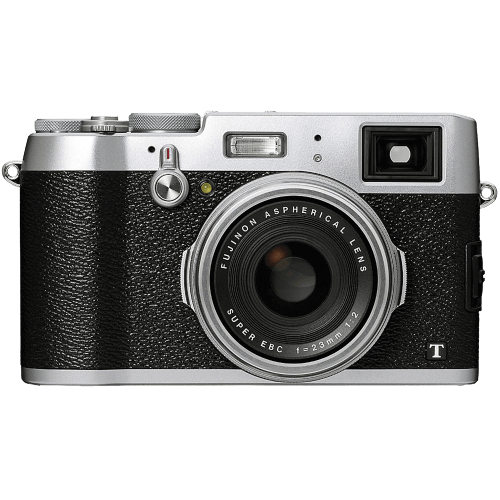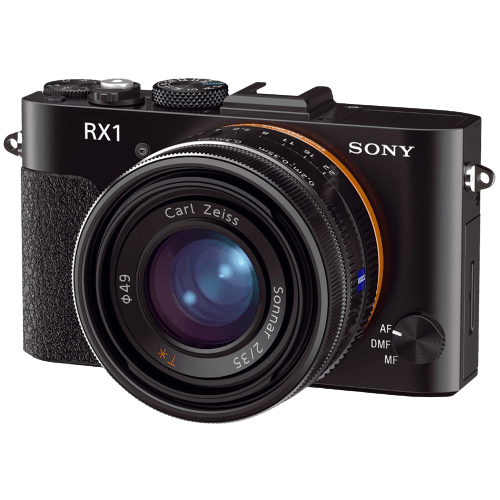Fujifilm X100T vs Sony Cyber-shot DSC-RX1 Comparison
Fujifilm X100T

Sony Cyber-shot DSC-RX1

The Sony Cyber-shot DSC-RX1 outperforms the Fujifilm X100T with a score of 57/100 compared to 53/100. Both cameras share some similarities, such as being released in the early 2010s and having similar dimensions. However, the Fujifilm X100T is a mirrorless camera, while the Sony DSC-RX1 is a compact camera.
The Fujifilm X100T has the advantage of being lighter at 440g compared to the Sony DSC-RX1’s 482g. On the other hand, the Sony DSC-RX1 boasts a higher score, making it a better camera despite its heftier weight and higher launch price of $2800 compared to the Fujifilm X100T’s $1300.
Taking these factors into account, the Sony Cyber-shot DSC-RX1 emerges as the better choice for those prioritizing camera quality, while the Fujifilm X100T may be more suitable for those seeking a lighter, more budget-friendly option.
Fujifilm X100T vs Sony Cyber-shot DSC-RX1 Overview and Optics
The Sony Cyber-shot DSC-RX1 emerges as the winner in the optics comparison with a score of 67/100, while the Fujifilm X100T trails behind at 54/100. Both cameras share some common specifications such as having a CMOS sensor, fixed lens mount, and no image stabilization.
The Sony RX1 outperforms the Fujifilm X100T in several aspects. With 24.3 megapixels, the RX1 offers a higher resolution compared to the X100T’s 16 megapixels, resulting in more detailed images. Additionally, the RX1 has a full-frame sensor, which contributes to better image quality, low-light performance, and dynamic range. Its DXOMARK score of 93 for the sensor further supports its superior image quality.
On the other hand, the Fujifilm X100T has a faster shooting speed of 6 frames per second (fps) compared to the RX1’s 5 fps. This makes the X100T slightly better for capturing fast-moving subjects or continuous shooting. However, the advantage is marginal and may not be significant for most users.
The X100T also features the EXR Processor II, while the RX1 uses the Bionz processor. Although the processors may have different capabilities, it is difficult to determine which one is better based solely on their names. Similarly, the X100T’s sensor size is APS-C, which is smaller than the RX1’s full-frame sensor, but it does not have a DXOMARK score for comparison.
In conclusion, the Sony Cyber-shot DSC-RX1’s higher score reflects its better optics, particularly in terms of resolution and sensor size. While the Fujifilm X100T has a slightly faster shooting speed, the overall image quality and performance favor the RX1.
Fujifilm X100T vs Sony Cyber-shot DSC-RX1 Video Performance
The Fujifilm X100T outperforms the Sony Cyber-shot DSC-RX1 in video capabilities, scoring 70/100 compared to the Sony’s 56/100. Both cameras share common specifications, including Full HD video resolution, video dimensions of 1920 x 1080, and a maximum video frame rate of 60fps. Despite these similarities, the Fujifilm X100T offers some advantages over the Sony DSC-RX1.
The winning feature of the Fujifilm X100T is its built-in time-lapse functionality. This enables users to create stunning time-lapse videos without the need for additional equipment or software. The Sony DSC-RX1 lacks this feature, limiting its creative potential for video enthusiasts. This key difference contributes to the Fujifilm X100T’s higher score in video capabilities.
However, the Sony DSC-RX1 does have some advantages in other areas, although not necessarily in video capabilities. For instance, it may offer better image quality, autofocus performance, or battery life. These factors could influence a user’s decision if they prioritize still photography over video performance.
In comparing the video capabilities of the Fujifilm X100T and the Sony Cyber-shot DSC-RX1, the Fujifilm X100T emerges as the better option, primarily due to its built-in time-lapse functionality. While both cameras have comparable video specifications, the X100T’s additional feature makes it more appealing to those who prioritize video performance. However, users should also consider the other aspects of each camera to determine which best meets their needs.
Fujifilm X100T vs Sony Cyber-shot DSC-RX1 Features and Benefits
The Fujifilm X100T emerges as the winner in the features comparison, scoring 58/100, while the Sony Cyber-shot DSC-RX1 scores 44/100. Both cameras share some common specifications, such as a 3-inch screen size, no touchscreen, flip screen, and no GPS.
The Fujifilm X100T excels in some areas compared to the Sony Cyber-shot DSC-RX1. It has a higher screen resolution at 2,360,000 dots, which results in a sharper display for reviewing images and navigating menus. The X100T also includes WiFi and Bluetooth connectivity, making it easier to transfer images and control the camera remotely using a smartphone.
On the other hand, the Sony Cyber-shot DSC-RX1 does not offer any significant advantages over the Fujifilm X100T in terms of features. It has a lower screen resolution of 1,229,000 dots and lacks WiFi and Bluetooth connectivity. These shortcomings put the RX1 at a disadvantage when compared to the X100T.
Considering these points, the Fujifilm X100T stands out as the better choice in terms of features. Its higher screen resolution and added connectivity options make it more versatile and user-friendly. Meanwhile, the Sony Cyber-shot DSC-RX1’s lower feature score reflects its limited offerings, making it less appealing to users seeking a camera with more advanced features.
Fujifilm X100T vs Sony Cyber-shot DSC-RX1 Storage and Battery
The Fujifilm X100T outperforms the Sony Cyber-shot DSC-RX1 in storage and battery with a score of 21/100 compared to 16/100. Both cameras share common specifications, including one memory card slot and compatibility with SD, SDHC, and SDXC memory cards. Neither camera offers USB charging.
The X100T is superior in battery life, providing 330 shots per charge with its Lithium-Ion NP-95 battery, while the RX1 only manages 270 shots with its NP-BX1 battery. The RX1, however, accepts Memory Stick Pro Duo and Pro-HG Duo cards in addition to SD-type cards, offering more storage options.
Considering these factors, the Fujifilm X100T proves to be a better choice in terms of battery life, while the Sony Cyber-shot DSC-RX1 provides slightly more versatility in memory card compatibility.
Fujifilm X100T vs Sony Cyber-shot DSC-RX1 – Our Verdict
Are you still undecided about which camera is right for you? Have a look at these popular comparisons that feature the Fujifilm X100T or the Sony Cyber-shot DSC-RX1:

